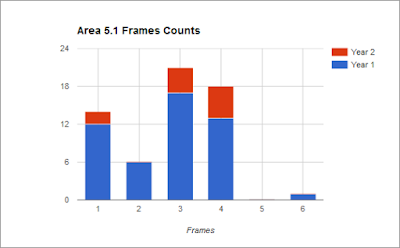I decided to put together what I had to see if I could get away with it, but my concerns turned out to be justified. It wasn't working very well in that format.
| The first (two frame) version of Biker Safety |
I wondered why this was and came up with the following observations:-
- The pictures are too similar and there's not enough separation (so you look down to the last image too early).
- There isn't enough misdirection to trick you into thinking the joke is about safety.
- It doesn't follow the rules of three. (see what I did there?.. no,..ok I'll explain in a bit)
Lies, Damn Lies and Statistics
I like quoting Mark Twain, but before I start talking about the rule of three I thought it might be interesting to review the number of frames used for each Area 5.1 cartoon. I dropped the tally into a bar graph and it became obvious that I primarily use one, three or four pictures per strip.There's actually more single frame work than I'd expected, but a fair amount of this was computer game themed "filler" cartoons from the first year. Back then I was still trying to ensure a weekly output, I've since given over to "a weakly output" of just a couple per month.
What does this tell us?.. well I'm not sure, perhaps that my preference is for ideas that need a bigger setup. Or maybe that I tend to split more wordy dialogue over additional frames to keep it manageable. But could it be that there's something subtle going on that I hadn't realised?
Three's a Jolly Good Fellow
OK sorry about that, couldn't resist it!.. so what's this rule of three then?Quite simply it's the idea that things are more memorable if they are in threes. Consider the following famous examples:-
- Friends, Romans, countrymen.
- Faith, hope and charity.
- Stop, look and listen.
- The good, the bad and the ugly.
It's commonly used in humour and to illustrate I've included this great joke example from Laura Kightlinger that uses a shocking third element..
"I can’t think of anything worse after a night of drinking than waking up next to someone and not being able to remember their name, or how you met, or why they’re dead."
- Starting Point (waking up next to an unknown person)
- Misdirection following a common theme (can't remember how you met)
- Punchline (or why they're dead)
Fixing my cartoon
So I went back to the drawing board, desparate to find my misdirection element, and it wasn't until I switched from safety to other biker requirements that I finally found the answer. But it meant I had to finally give one of my characters a name.| The missing middle element |
I hope you found that as interesting as I did,.. if you haven't already seen it, check out the finished cartoon here --> http://area5-1.webcomic.ws/comics/67/


No comments :
Post a Comment